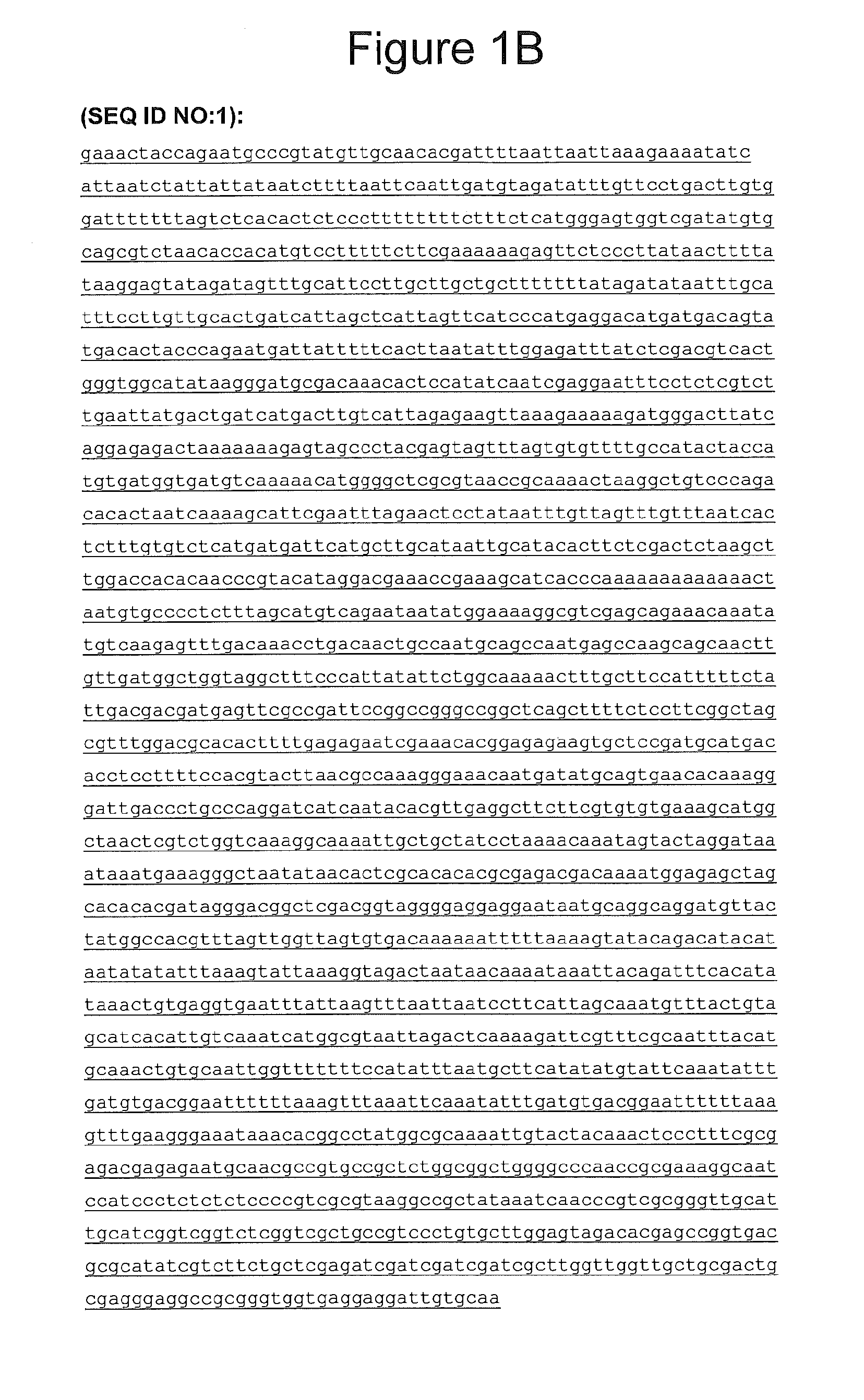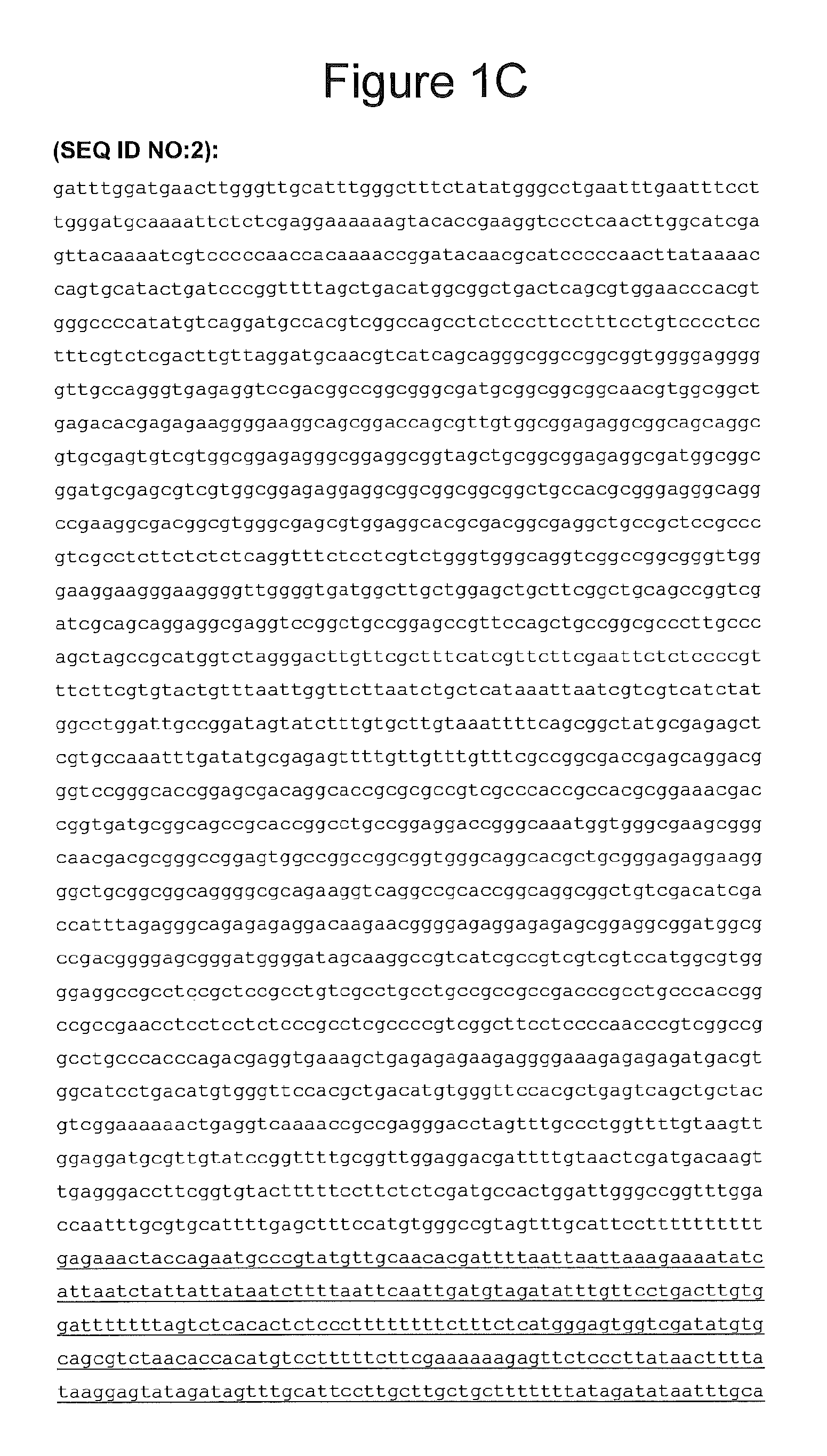Methods of increasing tolerance to heat stress and amino acid content of plants
a technology of amino acid content and heat stress, which is applied in the direction of angiosperm/flowering plants, biochemistry apparatus and processes, enzymes, etc., can solve the problems of adversely affecting the growth and development of plants, adversely affecting various aspects of plant growth and development, and the world's population may be particularly susceptible to heat stress, so as to achieve the effect of increasing tolerance to heat stress
- Summary
- Abstract
- Description
- Claims
- Application Information
AI Technical Summary
Benefits of technology
Problems solved by technology
Method used
Image
Examples
example 1
Characterization of OsMYB55
[0267]The 867 bp full length cDNA sequence (SEQ ID NO:4; FIG. 1E) of OsMYB55 encodes an R2R3-MYB transcription factor predicted to be 289 amino acids in length (SEQ ID NO:5; FIG. 1F). A BLAST® (National Center for Biotechnology Information, Bethesda, Md.) search was used to identify homologues of OsMYB55. Amino acid sequences of the closest homologs (SEQ ID NOs:6-13; FIGS. 17A-H) were used to generate a phylogenetic tree showing the similarity between OsMYB55 and its homologues (FIG. 1A).
[0268]The genomic DNA sequence containing the 5′UTR, promoter sequence, the MYB55 coding region (containing three exons and two introns) and 3′ UTR are shown in FIG. 1D (SEQ ID NO:3); the 5′ UTR and promoter sequence alone are shown in FIG. 1C (SEQ ID NO:2). A 2134 bp portion of the OsMYB55 promoter sequence (lacking nucleotides −1 to −5) is shown in FIG. 1B (SEQ ID NO:1) and was used to construct a GUS reporter construct (Example 3).
[0269]To understand the regulation of t...
example 2
OsMYB55 Expression is Up-Regulated in Response to Heat Stress: OsMYB55 Transcripts
[0271]Seeds from wild-type rice plants were planted in 500 ml pots containing a growth media comprising peat moss and vermiculite in a ratio of 1:4. Plants were grown in growth cabinets (Conviron, Manitoba, Canada) under full-nutrient conditions using 1 g of a slow-release fertilizer containing nitrogen, phosphorus and potassium (13-13-13) and supplemented with micronutrients. Plants were grown under normal growth conditions for four weeks.
[0272]Following four weeks of growth under normal growth conditions, plants were exposed to 45° C. for 0, 1, 6 or 24 hours. Leaves were harvested from each plant, frozen immediately in liquid nitrogen and stored at −80° C.
[0273]Quantitative real-time RT-PCR analysis of the leaves showed that OsMYB55 expression was up-regulated following exposure to 45° C. for one hour and that OsMYB55 expression returned to basal levels following exposure to 45° C. for 6 or 24 hours ...
example 3
OsMYB55 Expression is Up-Regulated in Response to Heat Stress: GUS Reporter Protein
[0274]To generate the OsMYB55promoter-GUS construct, a 2134 base pair fragment of the OsMYB55 promoter region was amplified from genomic DNA using the OsMYB55promoter-BamH1 forward primer (5′-TGGTGAGGAGGATTGTGCAAGGATCCGCG-3′; SEQ ID NO:21) and the OsMYB55promoter-EcoR1 reverse primer (5′-CCGGAATTCTTGCACAATCCTCCT CACCA-3′; SEQ ID NO:22).
[0275]DNA was isolated from four-week-old plants grown under normal growth conditions using the cetyl trimethylammonium bromide (CTAB) extraction method. The amplified fragment (SEQ ID NO:1; FIG. 1B) was cloned into the multiple cloning site of the pCAMBIA1391Z (Cambia, Brisbane, Australia) between the BamHI and EcoRI restriction sites to drive expression of the GUS reporter protein. Transgenic rice lines comprising the OsMYB55promoter-GUS construct were generated using Agrobacterium-mediated transformation, and positively transformed lines were selected according to th...
PUM
| Property | Measurement | Unit |
|---|---|---|
| Fraction | aaaaa | aaaaa |
| Concentration | aaaaa | aaaaa |
| Content | aaaaa | aaaaa |
Abstract
Description
Claims
Application Information
 Login to View More
Login to View More - Generate Ideas
- Intellectual Property
- Life Sciences
- Materials
- Tech Scout
- Unparalleled Data Quality
- Higher Quality Content
- 60% Fewer Hallucinations
Browse by: Latest US Patents, China's latest patents, Technical Efficacy Thesaurus, Application Domain, Technology Topic, Popular Technical Reports.
© 2025 PatSnap. All rights reserved.Legal|Privacy policy|Modern Slavery Act Transparency Statement|Sitemap|About US| Contact US: help@patsnap.com



